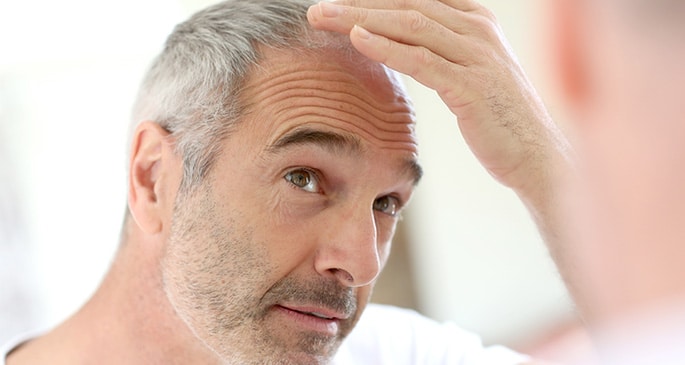
What causes hair loss?
Hair loss can affect just your scalp or your entire body. It can be the result of heredity, stress, certain medications, or an underlying medical condition. Anyone — men, women, and children — can experience hair loss. Treatments vary depending on the cause, but our hair loss experts will help determine the cause and establish the appropriate treatment plan.
What are the common types of hair loss?
Pattern hair loss:
- Pattern hair loss, or androgenic alopecia, is the hair thinning that occurs commonly with age. It has a strong genetic component from both the mother or father’s side and can start even in our 20’s. Typical pattern hair loss in women is a widened frontal part or thinning most noticeable on the frontal scalp. Treatment options are somewhat limited–Rogaine 5% foam or solution has the most data supporting its use. A less effective alternative is the testosterone-blocking medication spironolactone. If advanced enough, hair transplants may be a very esthetically pleasing option, but will require thicker hair at the back of the scalp to serve as the donor site.
Medical hair loss:
- Hair loss as a direct result of a medical issue (most commonly thyroid, anemia, and hormone) can be either sudden or insidious and presents as increased hair shedding often leaving generalized thinning over the entire scalp. The medical abnormalities can be detected with simple blood work and can then be corrected with medications or supplements. The hair loss may take months or even a year to fully recover.
Stress-related hair loss:
- Stress-related hair loss, or telogen effluvium, oftentimes presents after giving birth, but any significant stress on the body can induce this reaction. Essentially, the body focuses its attention elsewhere and forces a higher proportion of hairs into the shedding, or telogen, phase than is normally the case. These stressors include high fever, crash diet/sudden weight loss, medication change (including birth control pill), significant surgery, or significant emotional stress (such as divorce, death of a family member). This also presents with increased shedding and generalized thinning over the entire scalp. Once there has been a full recovery from the stressor, the hair loss may again take months or even a year to reverse. Topical/oral therapy has no effect for this type of hair loss.
Autoimmune hair loss:
- Autoimmune hair loss, or alopecia areata, is the most unique presentation of hair loss with the often sudden appearance of round or coin-shaped patches of baldness anywhere on the scalp (or less often in the eyebrow or beard areas). Alopecia areata often occurs in the younger population. It is thought to be a process in which the hair follicles go into hibernation. Alopecia areata is known to be a very unpredictable condition, with hair falling out and growing back at any time and seemingly without a pattern. Very rarely all scalp or body hair is lost (which is rapid in onset and difficult to reverse). Much more commonly, this type of hair loss is easily treatable and fully reversible with steroid injections into the bald areas.
Hair follicle damage:
- Traction alopecia is a type of hair loss that occurs from a chronic tension on the hair follicle from a tight hairstyle worn over many years. The typical presentation is a recession of the frontal and temporal hairlines. This hair loss often occurs in the African-American population as a result of braiding or tight extensions. Removing the tension on the hair follicle will stop the progression of damage, but this hair loss tends to be permanent in nature.